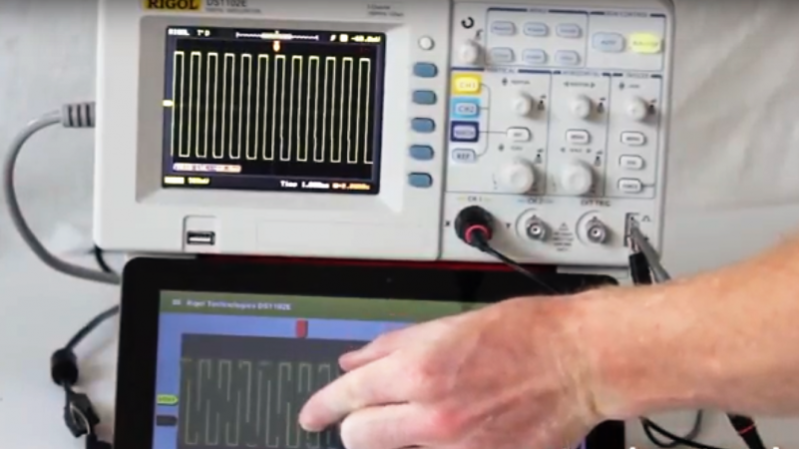With pervasive smartphones and tablets, the touch interface is assumed for small LCD screens, and we’ve likely all poked and pinched at some screen, only to find it immune to our gestures. Manufacturers have noticed this and begun adding touch interfaces to instruments like digital oscilloscopes, but touch interfaces tend to be an upgrade feature. But thanks to this hybrid oscilloscope touchscreen interface, even the low-end scopes can get in on the action.
It only makes sense that [Matt Heinz] started with one of the most hackable scopes for this build, which was his Master’s thesis project. Using an Android tablet as an auxiliary interface, [Matt] is able to control most of the main functions of the scope remotely. Pinching and expanding gestures are interpreted as horizontal and vertical scaling, while dragging the displayed waveform changes its position and controls triggering. While it’s not a true touchscreen scope, the code is all open source, so can a true aftermarket Rigol touchscreen be far away?
Rigol hacks abound here — you can talk to them in Linux, increase the bandwidth, or just get a look at their guts.
Thanks to [Matt]’s former teacher [floe] for the tip.















Excellent!
Knob is a KISS solution that simply works.
I guess I’m bit old school and like having knobs to twiddle but that is really cool.
Having a remote head for the scope could come in handy.
That is really neat. Cool!
I was looking at touch screens last night and thinking about if I take the touch screen off an 8″ Android notepad and install the rest in the computer, replacing the screen for the CRT on the TDS-520 I have… that would provide more options through GPIB and be RF quieter than if I hacked in another board like an Orange Pi or even a desktop board because does look like will fit. I was hoping I can find a magnetic bearing fan… though nothing is powerful enough and I am starting to go off on a tangent
The issue i am finding with the Andoird hack route is software that is android based, to do everything a windows based application can do already. I was going to look and see if there are Windows OS hacks onto android hardware as an option and haven’t gotten that far yet.
Also, if I understand correctly; the older scopes will more likely, to avoid more soldering work, be interfaced through the serial, centronics or GPIB port for ease of interface and I am not aware of other than direct memory processes access to maybe the operation firmware configuration settings and outputs to the screen… the ability like the modern scopes to have libraries and memory allocated where all the oscilloscope controls are interfaced with the software.
I am guessing that is how this is working. For each control (dial, rotary switch, or button) there is some sort of software interface already available in the operating system of the oscilloscope where memory is allocated I’m thinking to update settings when initialized and changed… so figuring out the libraries syntax to access the memory to program a custom interface isn’t as challenging I’m thinking with the newer scopes.
I might be wrong… I’ll have to read the links to see what’s the scoop on the Rigol links for ideas. The hybrid interface is way interesting. Makes me think we can make wireless probes and screen interfaces to better systems that can stay in the vehicle or base too.
I remember the time when I got to try using one of those really fancy Agilent scopes ( the kind that costs as much as a nice car) and after they said it was touchscreen, the first thing I tried was zooming in on the waveform like you do on an iPhone! I was very surprised at how “cheap” the touchscreen felt and of course, it didn’t respond as I expected.
I would suspect that’s because most of the Agilent scopes run Windows, and the touchscreen is nothing more than a mouse driver. That’s based on my experience with implementing touch screens on Point Of Sale (POS) terminals.
Same as the touch screen on the snap on diagnostic machine I just bought(that did cost more than my car lol) it’s nothing like a modern capacitive multi-touch phone screen. Tho I prefer to use the buttons as my hands are often too grubby to be poking at the screen.